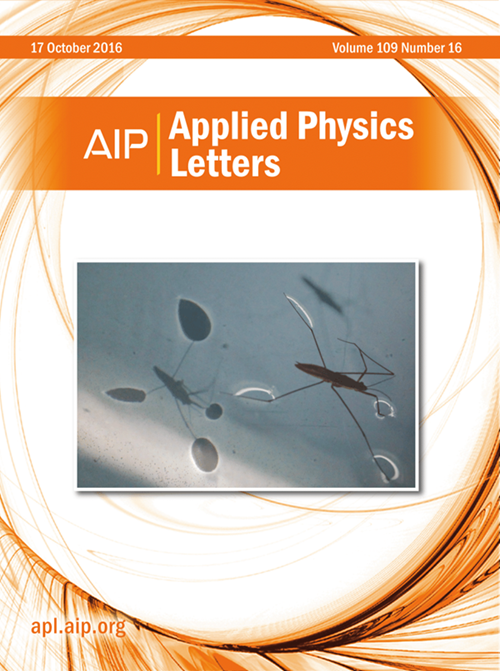聚焦数字间换能器声驱动磁电天线的全向磁声耦合
IF 3.5
2区 物理与天体物理
Q2 PHYSICS, APPLIED
引用次数: 0
摘要
声驱动磁电(ME)天线为实现数量级小型化提供了一种很有前途的方法。然而,传统的基于谐振器的ME天线存在大量的声能泄漏,这限制了磁致伸缩(MS)薄膜中磁声耦合效应的有效利用。在这项工作中,我们提出并实验证明了一种基于压电绝缘体衬底的表面声波ME天线。通过采用聚焦数字间换能器,我们对声波进行了空间限制,显著提高了MS膜内的声能密度,从而提高了磁声耦合的效率。实验结果表明,加载MS膜后,天线的辐射功率比未加载的参考结构增加了32.55倍,增益为- 26.78 dBi,机电耦合系数k2为8.79%,品质因子Q为217,品质因数(FoM, k2×Qmax)为19.07。此外,施加300 Oe的外部偏置磁场调制磁晶各向异性,导致天线的谐振特性增强1.84%,辐射性能提高7.15%。通过改变磁场方向,我们进一步验证了所提出结构的全向磁声耦合行为。这些发现为具有增强性能和可调性的下一代小型化天线的设计提供了见解。本文章由计算机程序翻译,如有差异,请以英文原文为准。
Omnidirectional magneto-acoustic coupling in acoustically driven magnetoelectric antenna with focused interdigital transducers
Acoustically driven magnetoelectric (ME) antennas present a promising approach for achieving orders-of-magnitude miniaturization. However, conventional resonator-based ME antennas suffer from substantial acoustic energy leakage, which limits the effective utilization of the magneto-acoustic coupling effect in the magnetostrictive (MS) film. In this work, we propose and experimentally demonstrate a surface acoustic wave ME antenna based on a piezoelectric-on-insulator substrate. By employing focused interdigital transducers, we spatially confine acoustic waves, significantly enhancing the acoustic energy density within the MS film and thereby improving the efficiency of magneto-acoustic coupling. Experimental results reveal that with MS film loading, the antenna's radiated power increases by a factor of 32.55 compared to an unloaded reference structure, achieving a gain of −26.78 dBi, an electromechanical coupling coefficient (k2) of 8.79%, a quality factor (Q) of 217, and a figure of merit (FoM, k2×Qmax) of 19.07. Furthermore, applying an external bias magnetic field of 300 Oe modulates the magnetocrystalline anisotropy, leading to a 1.84% enhancement in the antenna's resonance characteristics and a 7.15% improvement in radiation performance. By varying the magnetic field orientations, we further verify the proposed structure's omnidirectional magneto-acoustic coupling behavior. These findings provide insights into the design of next-generation miniaturized antennas with enhanced performance and tunability.
求助全文
通过发布文献求助,成功后即可免费获取论文全文。
去求助
来源期刊

Applied Physics Letters
物理-物理:应用
CiteScore
6.40
自引率
10.00%
发文量
1821
审稿时长
1.6 months
期刊介绍:
Applied Physics Letters (APL) features concise, up-to-date reports on significant new findings in applied physics. Emphasizing rapid dissemination of key data and new physical insights, APL offers prompt publication of new experimental and theoretical papers reporting applications of physics phenomena to all branches of science, engineering, and modern technology.
In addition to regular articles, the journal also publishes invited Fast Track, Perspectives, and in-depth Editorials which report on cutting-edge areas in applied physics.
APL Perspectives are forward-looking invited letters which highlight recent developments or discoveries. Emphasis is placed on very recent developments, potentially disruptive technologies, open questions and possible solutions. They also include a mini-roadmap detailing where the community should direct efforts in order for the phenomena to be viable for application and the challenges associated with meeting that performance threshold. Perspectives are characterized by personal viewpoints and opinions of recognized experts in the field.
Fast Track articles are invited original research articles that report results that are particularly novel and important or provide a significant advancement in an emerging field. Because of the urgency and scientific importance of the work, the peer review process is accelerated. If, during the review process, it becomes apparent that the paper does not meet the Fast Track criterion, it is returned to a normal track.
 求助内容:
求助内容: 应助结果提醒方式:
应助结果提醒方式:


